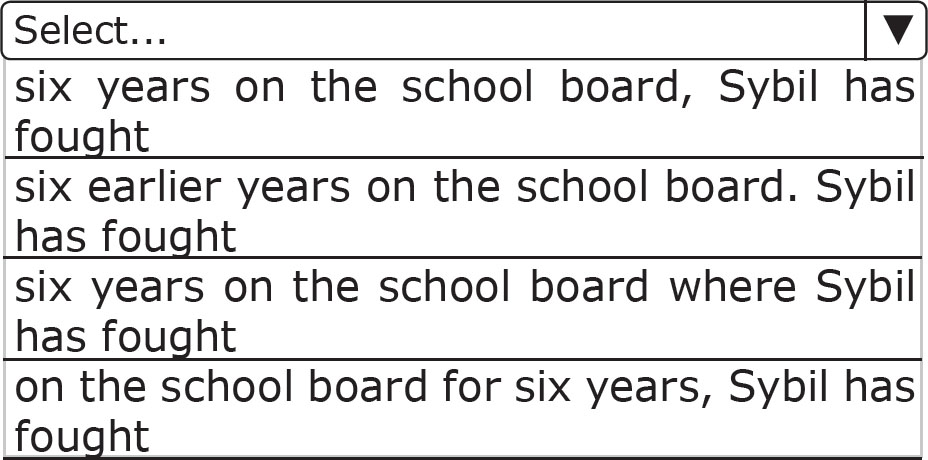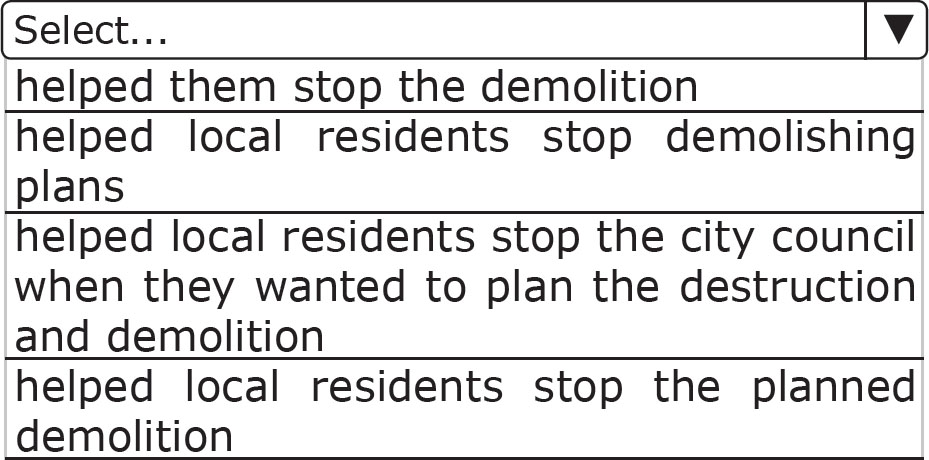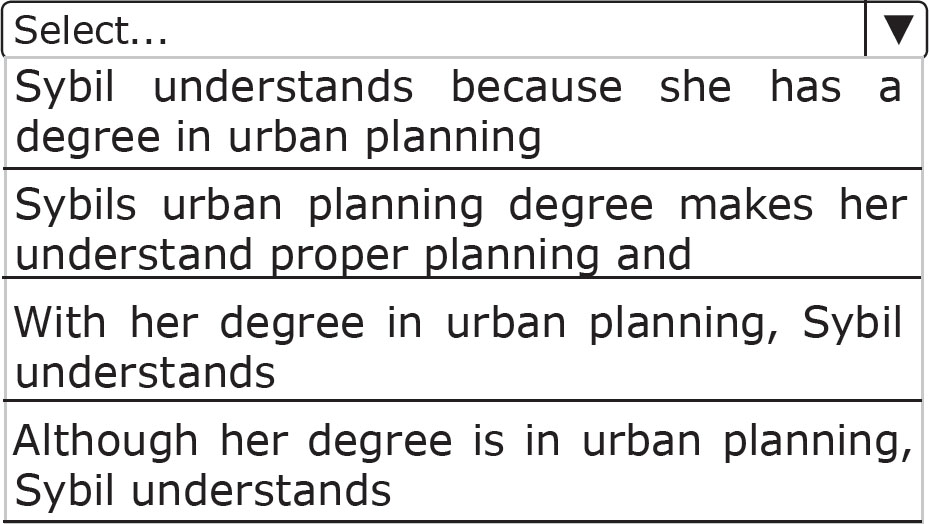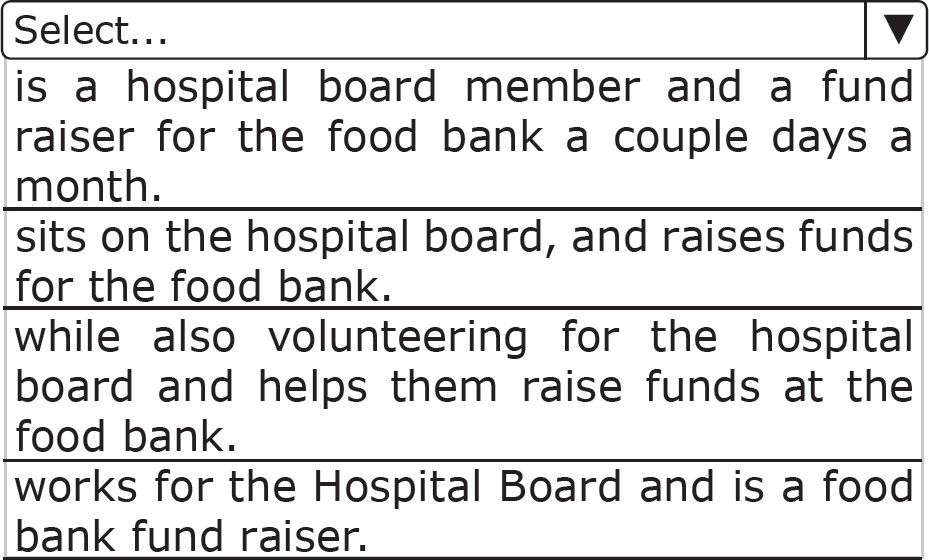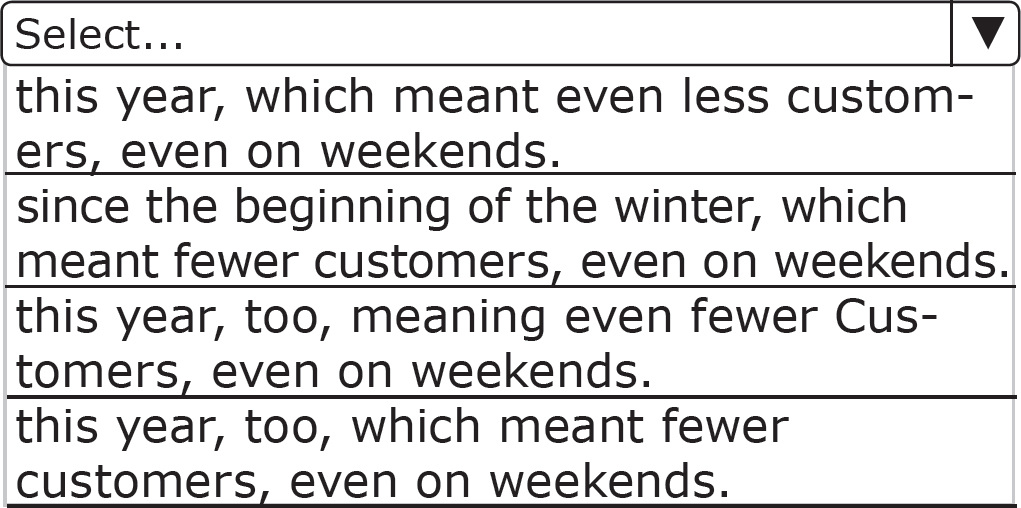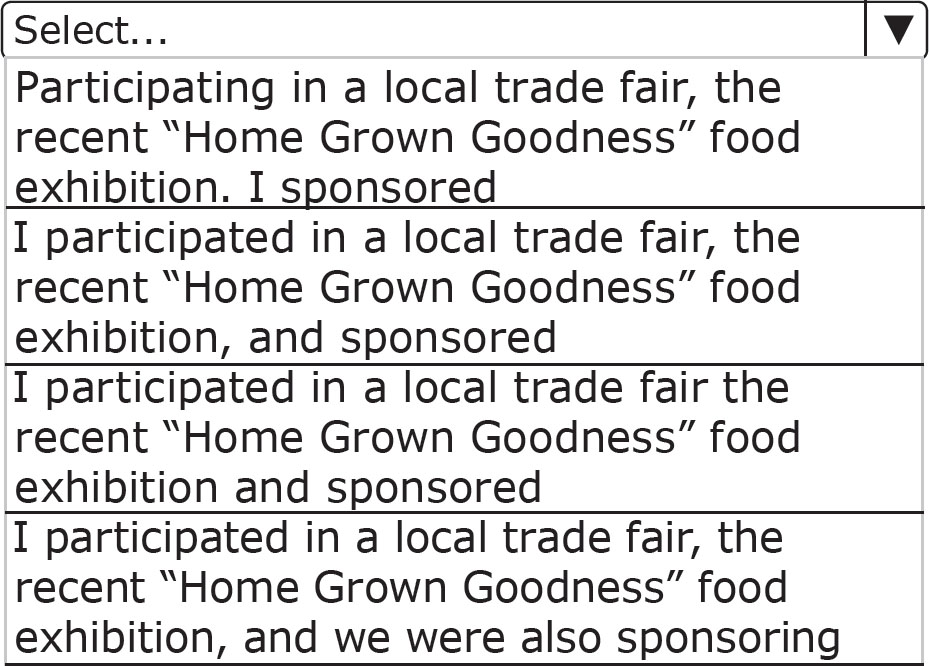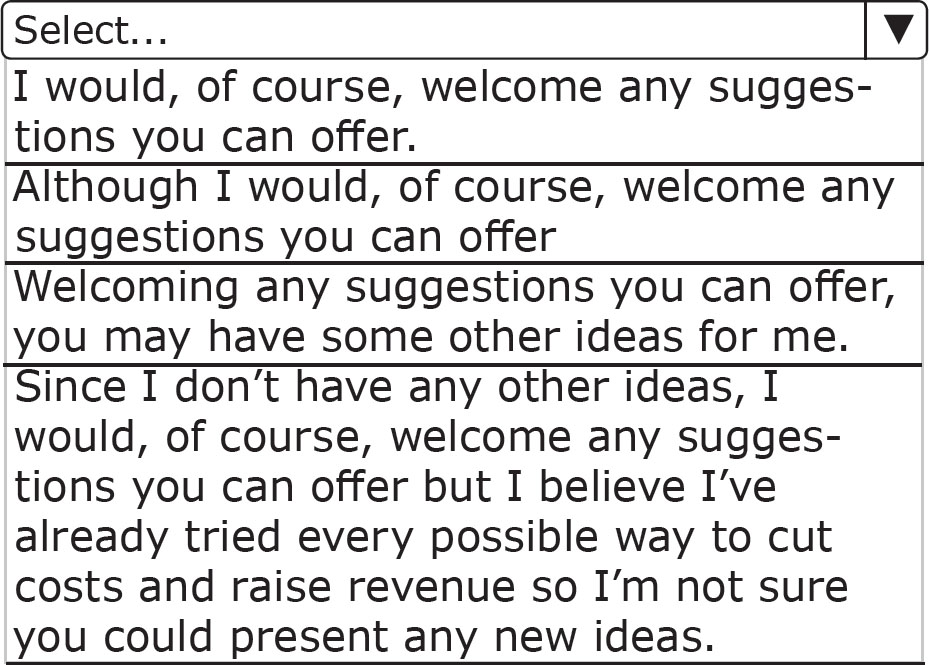Chapter 9
Language Questions
In this chapter, you’ll learn how the format of the language questions can help you find the answer more easily.
Sometimes it’s easier to figure out what you don’t want than what you do. Shopping for a car or a place to live can be like that—you hate the transmission shift or the neighborhood, but couldn’t explain exactly why or describe what would make you happier instead.
So it is with the language questions, only in this case, getting rid of what’s clearly wrong should, ideally, leave you with what’s right. You don’t need to know exactly why an answer is wrong—perhaps it just sounds odd—but as long as you can find and eliminate at least a couple of those incorrect choices, you’re closer to the right answer.
WHAT KIND OF QUESTIONS ARE ON THE TEST?
Now that we’ve reviewed the key language use skills that are targeted on the test (see Chapter 8 on this page), let’s see how the questions make it easier to find the right answers. The language questions are all drop-down items within a passage. There will be a big gap in a sentence, with the word “Select” in the gap. When you click on it, a menu of four possible answers drops down. Click on an answer from that list and poof!—magically it appears where the gap was. (See this page in Chapter 3 for an illustration of a drop-down question.)
There are two good things about that type of question: One, you get to see your answer within the context of a passage right away, and two, there has to be one correct choice within the four options. It’s much easier to judge whether an answer seems right in the context of a passage than it is in an isolated sentence.
Drop-down questions let you see your chosen answer in the context of the passage.
What Strategies Should I Use to Answer the Questions?
The wrong answers represent common errors in any of the eight language use areas covered in Chapter 8. You don’t need to remember the names of the errors or how to fix them, although reviewing the list will help you learn to recognize them more quickly. All you need to do is use Process of Elimination to identify the three wrong choices, click on the fourth one, and verify that it is correct when read in the context of the passage.
You do need to be careful when you’re reading the choices, though, because they can be very close to each other in wording, and time pressure can trip you up. Would you notice the difference between these two answer choices on a test?
“…your poor customer service and having high costs. if you…”
“…your poor customer service and high costs. If you…”
The first one lacks parallel structure in the last two items on a list, and is missing a capital letter at the beginning of the next sentence. If you were skimming the answer choices quickly, though, the two seem close. Those are the kinds of tricky differences the test writers can and do throw at you.
Read Carefully. One comma or capital letter can make the difference between a right and a wrong answer.
A good approach is to compare the choices that are left after you’ve eliminated those that are wrong. Is one answer missing a capital letter where it should have one? Does one have an extra word, such as “although,” that turns a complete sentence into a fragment? The difference between a right and a wrong answer can be that small.
After you’ve made your final choices, check your answers in the context of the passage. Context can be a huge help in showing you whether you’ve made the right decision.
How Do the Drop-Down Questions Look in a Language Passage?
Here’s an example of a typical GED® language passage. It’s a flyer that a candidate for mayor is using to introduce herself to voters, and it needs some help. Try to select the correct answer yourself, circling it with a pencil, before you read the explanations that follow the passage. The wording for the passage instructions is the same as the wording you’ll see on the test.
Review the language use errors in Chapter 8 so you can spot wrong answers more quickly.
The passage below is incomplete. Navigate to each “Select…” button and choose the option that correctly completes the sentence.
A Mayor for the Rest of Us!
Sybil Simbalah lives in a neighborhood like yours. She grew up here, and has watched this city change from a family-friendly place into a sprawl of uncontrolled urban development, fueled by your tax dollars and pouring profits into the pockets of corrupt elected officials and their buddies in business and industry.
During four years on the city council and, before that,
tirelessly and courageously for family values. She gathered enough support to defeat the ill-conceived expansion of the freeway through town, and
of a beautiful 100-year-old library building. She has fought every proposed rate hike for mass transit and, on the school board, defeated a plan to cut back after-school programs.
what makes a city welcoming, healthy, and livable. She is always ready to hear from the people she represents, and consults with her constituents before she votes on any major project.
Sybil lives in a century-old house with her husband, three children, and three dogs. She chairs the symphony’s community engagement committee,
Sybil Simbalah knows what the residents of this city need.
As long as the current city officials run the show, their cronies in industry and big business will continue getting the contracts—and the kickbacks—for massive projects we can’t afford and don’t need.
You can end corruption in city hall and stop big business and industry from dictating where your tax dollars go.
It’s time to capture city hall—for the rest of us!
On November 13, take back control of your city and vote Sybil Simbalah for mayor!
To join Sybil’s team of eager volunteers or contribute to Sybil’s campaign, contact her campaign office at
We’d love to hear from you or meet you!
Now let’s go through the process for finding the errors and choosing the correct answers to complete the four sentences.

Apply the Strategy
Use POE on Language questions like the ones in this passage!
In the first set of drop-down answers, the first choice is correct. Read on to see how you could have eliminated the other three (which all contain errors in the key language skills) and arrived at this one through Process of Elimination.
During four years on the city council and, before that, six years on the school board, Sybil has fought tirelessly and courageously for family values.
The second choice (below) is wordy—“before that” and “earlier” say the same thing. Only one word (“earlier”) separates this answer from the correct choice, but that’s enough to make this one wrong. That’s why you need to read the answer choices very carefully.
During four years on the city council and, before that, six earlier years on the school board. Sybil has fought tirelessly and courageously for family values.
The addition of “where” in the choice below makes the sentence into a fragment instead of a complete sentence. Again, only one word separates this choice from the correct answer.
During four years on the city council and, before that, six years on the school board where Sybil has fought tirelessly and courageously for family values.
The fourth choice (below) lacks parallel construction.
During four years on the city council and, before that, on the school board for six years, Sybil has fought tirelessly and courageously for family values.
In the second set of drop-down answers, the first choice is wrong because it has an unclear antecedent. (See this page in Chapter 8.) Who is “them”?
She gathered enough support to defeat the ill-conceived expansion of the freeway through town, and helped them stop the demolition of a beautiful 100-year-old library building.
The next choice (below) has awkward, unclear wording that would confuse a reader. Is “demolishing” a verb or an adjective here? Are the residents demolishing (a verb) plans, or are they stopping plans that describe demolishing (an adjective)?
She gathered enough support to defeat the ill-conceived expansion of the freeway through town, and helped local residents stop demolishing plans of a beautiful 100-year-old library building.
Now where do we start listing the problems with the third choice below? There’s a noun-pronoun agreement problem (“city council” is singular, so “when it wanted…), it’s wordy (what’s the difference between the “destruction” and the “demolition” of a building?), and it’s just plain longer than it needs to be.
She gathered enough support to defeat the ill-conceived expansion of the freeway through town, and helped local residents stop the city council when they wanted to plan the destruction and demolition of a beautiful 100-year-old library building.
The one below (the fourth choice) is the one you want. Now it’s clear whom (objective case—remember that one from Chapter 8?) Sybil helped and what she helped them do.
She gathered enough support to defeat the ill-conceived expansion of the freeway through town, and helped local residents stop the planned demolition of a beautiful 100-year-old library building.
In the third drop-down question, the first choice is wrong because it breaks up the independent clause (“Sybil understands what makes…”) with a dependent clause (“because she has a degree in urban planning”). The dependent clause should begin this particular sentence, followed by a comma (remember that from Chapter 8?) before the independent clause.
Sybil understands because she has a degree in urban planning what makes a city welcoming, healthy, and livable.
Aside from the fact that the second choice (below) is wordy (one would hope an urban planning degree would lead to an understanding of proper planning), the lack of an apostrophe on the possessive (“Sybil’s”) eliminates this version. You can see how carefully you need to read the choices when just one missing apostrophe means a wrong answer.
Sybils urban planning degree makes her understand proper planning and what makes a city welcoming, healthy, and livable.
After you eliminate the first two choices because of the errors in them, you come to the third choice (below), which is the correct one.
With her degree in urban planning, Sybil understands what makes a city welcoming, healthy, and livable.
Now why would anyone subordinate the urban planning degree with “although”? The degree explains Sybil’s understanding of a healthy city. This improper subordination in the fourth choice makes it sound as if her understanding is in spite of the degree, not because of it.
Although her degree is in urban planning, Sybil understands what makes a city welcoming, healthy, and livable.
In the final set of drop-down answers, the first choice (below) might have been the one you eliminated first. The structure in this list of volunteer activities isn’t parallel, and there is a problem with nonstandard word use (“a couple days a month” instead of “a couple of days a month”). It’s not clear whether the “couple of days” applies only to the food bank or to all three volunteer activities, either. Specifying the small amount of time Sybil devotes to volunteer activities also undercuts the image of extensive community involvement that she’s trying to present.
She chairs the symphony’s community engagement committee, is a hospital board member and a fund raiser for the food bank a couple days a month.
Yes, this is the one (the second option). The structure of the three descriptions of Sybil’s volunteer activity is parallel (each one begins with a verb) and there are no other errors.
She chairs the symphony’s community engagement committee, sits on the hospital board, and raises funds for the food bank.
This third choice was likely your second throw-away. The structure of the three volunteer activity descriptions isn’t even close to parallel, and it’s not clear who “them” means.
She chairs the symphony’s community engagement committee, while also volunteering for the hospital board and helps them raise funds at the food bank.
In addition to the lack of parallelism in the three volunteer activities, the fourth choice (below) has a capitalization problem. There is no reason to capitalize “Hospital Board” when the symphony committee and the food bank are not capitalized.
She chairs the symphony’s community engagement committee, works for the Hospital Board and is a food bank fund raiser.

Need More Help with Language?
Check out Grammar Smart, by the Staff of The Princeton Review.
Language Drill
Now you try a language passage on your own, circling your selections. Review the eight language use areas from Chapter 8 before you start; the errors you see will be in those eight areas. Remember to read the answer choices carefully, too, so you won’t miss a small difference between a wrong answer and one that’s correct. You can check your answers in Part VIII: Answer Key to Drills.
The passage below is incomplete. Navigate to each “Select…” button and choose the option that correctly completes the sentence.
Subject: Request to restructure loan
Dear Ms. Mertz:
Thank you again for your time during our phone conversation this morning. As requested, I am sending this email to confirm my request for a restructuring of my small business loan.
I would appreciate an additional six months to pay, and a 0.25 percent reduction in the interest rate. If you are unable to approve both requests, then the additional six months would be my priority.
Economic conditions have deteriorated since I first applied for a loan, unfortunately, with the result that I need to request this restructuring. My customers are spending more of their food dollars on groceries and less on restaurant meals. The harsh winter kept people at home more
You asked what efforts I’ve made to increase revenue by attracting new customers. Let me assure you that I have tried a variety of things during the past year. For example, I advertised in the local media, offering a special “new customer” discount.
a booth for a local charity at the fall fair. Hoping to attract new business from the surrounding communities, I promoted my restaurant through coupons and worked with a well-known insurance company to host special group dinners for its top salespeople in the region.
In spite of my efforts, however, any increase in customers is more than offset by the increase in my costs. Food is getting more and more expensive, and leasing and insurance costs are rising at a rate far greater than inflation. I changed the menu and laid off some staff in an attempt to reduce expenses. I have a small restaurant, though, and I can carry cost-cutting only so far before it starts to have a negative impact on my ability to keep my remaining customers happy.
Until the economy improves and people feel more comfortable spending on restaurant meals, I’m not sure what else I can do.
I realize you probably have several customers asking for the same type of loan relief as I am requesting.
would make me eligible for special consideration. I look forward to a favorable response after you have a chance to consult your manager.
Kind regards,
J. Enrico Flavino
Part III Summary
-
The Language test consists of two passages, each 350–450 words long and each with four drop-down sentence completion questions. Topics are drawn from the real world of business and professional communication. The language passages might be mixed in with the reading passages. You will have 95 minutes to answer all of the reading and language questions.
-
This section of the GED® test evaluates language use in editing tasks. The Extended Response section tests language use in a writing task.
-
Errors in the answer choices will fall within the eight areas of language use that are considered the most essential for career and college readiness:
-
Word choice: avoiding words that are often confused or used in a nonstandard way
-
Agreement: of subject and verb, of noun and pronoun
-
Pronoun use: clear antecedents, correct case
-
Modifiers: correctly placed
-
Joining thoughts: proper coordination, subordination, and parallel construction
-
Sentence construction: avoiding wordiness, run-on sentences, and fragments
-
Logic and clarity: effective use of words and phrases that mark a clear path for the reader
-
Punctuation and capitalization
-
Strategies for answering the questions include:
-
Using Process of Elimination to discard choices that are clearly wrong
-
Reading the answer choices carefully to spot small differences (such as one word or a punctuation mark) that can make one choice correct and another one wrong
-
Comparing the answer choices to identify the differences among them
-
Reading your chosen answer in the context of the passage to see if it fits with the context
